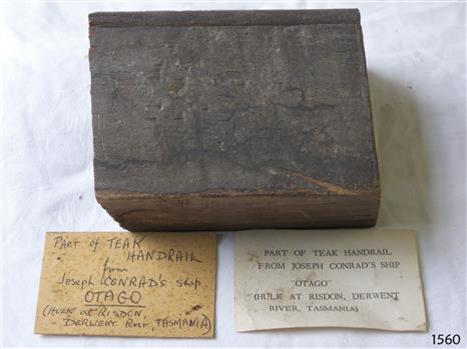Historical information
This teak wood sample was part of a handrail from the wreck of the ship Otago.
The Otago 1869-1931
The iron-hulled 3-masted barque Otago was built in Glasgow by Alexander Stephen & Sons Ltd, Kelvinhaugh, as a merchant ship and launched in 1869. The vessel changed hands several times in the late 19th century after being sold to an Australian firm in 1871. During one of its voyages, the captain died while the ship was in port at Bangkok. Marine author Joseph Conrad was on board and, being a qualified captain, he took command and continued the journey to Sydney and Mauritius. It was the only ship he ever commanded.
In 1903 the Melbourne shipping company Huddart, Parko & Co., purchased the Otago and converted it to serve as a coal hulk for use in Sydney. The Otago was later sent to Hobart, Tasmania, where it continued as a hulk until 1931. It was sold for scrap and eventually abandoned on the banks of the Derwent River at a place now known as Otago Bay, opposite Conrad Drive, Otago. The outline of the hull is still visible and a nearby plaque tells the story. There are other vessels also named Otago, one of them in the same year.
Joseph Conrad (1857-1927): -
Polish-born Joseph Conrad became a British subject in 1886. He was a renowned marine fiction writer and, for a short time, a mariner and Captain.
As a 13-year-old boy, Joseph Conrad desired to be a sailor. At 19, he joined the British merchant marine, working in several roles. He eventually qualified as a captain but only served in this role once: from 1888 to 1889, when he commanded the barque Otago, taking over from the deceased captain and completing the ship’s journey from Sydney to Mauritius.
In 1889 he began writing his first novel, Almayer’s Folly. He retired from life as a mariner in 1894, aged 36. Conrad’s affection for Australia and his visits to Australia from 1878 to 1982 were later commemorated by a plaque in Circular Quay, Sydney.
Conrad continued as an author; some characters in his books were said to be inspired by his maritime experiences and the people he had met. By the end of his life, he had completed 19 novels, many stories, and essays, plus one incomplete novel, Suspense, which was finished and published posthumously. In 1924, Prime Minister Ramsay MacDonald offered Conrad a knighthood for his work but he declined.
There is an 1882 sailing ship named the Joseph Conrad, after the author, that is now preserved at the Mystic Seaport Maritime Museum in the USA as part of the fleet of historic ships, used as an exhibit and a training ship. The Danish square-rigged training ship was originally named Georg Stage but was renamed by marine author Alan Villiers when he bought It in 1934.
Significance
The wood sample from the Otago is significant for its association with renowned marine author Joseph Conrad, who had once commanded the vessel; it was his only command as Captain and was known as Joseph Conrad's Otago.
The maritime connection with Conrad extends to items in the collection, including some of his maritime novels based on his first-hand knowledge, a wooden ship model of a ship named after him, and a navigation chart of Otago Harbour.
The sample of teak is significant as an example of materials used in the construction of the 1869 iron-hulled sailing ship, built in Glasgow, Scotland, specifically for use to sail across the world with cargo to trade between the colonies including Australian ports.
Physical description
Wood sample; a rectangular section of a teak wood handrail that has a bead planed along one side. Two cards with the sample have inscriptions, one handwritten and one typed. The sample is from the wreck of the barque Otago, once under the command of Captain Joseph Conrad.
Inscriptions & markings
Handwritten card: "PART OF TEAK HANDRAIL / from / Joseph CONRAD'S ship / OTAGO / (HULK at RISDON, DERWENT River, TASMANIA)
Typed card: "PART OF THE TEAK HANDRAIL / FROM JOSEPH CONRAD'S SHIP / "OTAGO" / (HILK AT RISDON, DERWENT / RIVER, TASMANIA)"
Subjects
- flagstaff hill,
- flagstaff hill maritime museum and village,
- warrnambool,
- maritime museum,
- maritime village,
- great ocean road,
- shipwreck coast,
- joseph conrad,
- joseph conrad's ship,
- captain joseph conrad,
- otago,
- barque otago,
- merchant ship,
- cargo ship,
- hulk,
- 1869 ship,
- iron hull,
- sailing ship,
- handrail,
- fitting,
- souvenir,
- wood sample,
- teak,
- new zealand,
- sydney,
- newcastle,
- tasmania,
- hobart,
- derwent river,
- otago harbour,
- otago bay,
- conrad drive,
- 19th century,
- mauritius,
- marine author,
- marine novel,
- alex villiers,
- georg stage
References
- New Zealand Geographic Joseph Conrad’s Ship: Joseph Conrad and the Otago by Charles Clark
- Britannica, The Editors of Encyclopaedia Biography; Joseph Conrad
- State Library South Australia Sailing Ship 'Otago' photograph
- The Newcastle Herald History: Joseph Conrad's Otago and its time in Newcastle by Mike Scandon June 26, 2105
- Tony Wheeler's Travels Conrad, the Otago & Incat, Feb 10, 2013
- ABC News Tasmania's connection to author Joseph Conrad remembered on anniversary of his death, by Carol Raabus Aug.3, 2016
- Mystic Seaport Museum Joseph Conrad: Full-rigged Ship
- Maritime Museum Tasmania The vessel OTAGO and author JOSEPH CONRAD




